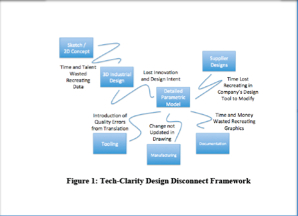A quick peek into some research on consolidating engineering / design suites. The report, Issue in Focus: Consolidating Design Software: Extending Value Beyond 3D CAD Consolidation extends prior Tech-Clarity research on the business value of consolidating CAD systems. That report, Consolidating CAD: Benefits of a Unified CAD Strategy, focused primarily on consolidating mechanical CAD. This report goes further to explore the added value of consolidating 2D sketching, industrial design, full parametric 3D design, and downstream design.
Maintaining Design Intent
There were a number of interesting findings in the report. One of the ones I found most compelling was the ability to maintain continuity of a design from conceptual sketches all the way to downstream functions that use product design data for their roles. By leveraging a common data model and allowing different design apps in the suite to manipulate it, companies have the potential to take a design through the following steps without having to recreate data in their own tools:
- Conceptual sketches
- 3D Conceptual design
- Detailed, parametric 3D design
- Tooling or installation design
- Documentation and communications
Too frequently, each of these steps introduces a new design tool. At these times, designers typically take the input from the previous design, interpret it, and recreate it in their tool of choice. This is inefficient, of course, but also breaks the continuity of innovation and opens up the opportunity to lose design intent.
Getting Off of the Data Translation and Recreation Bandwagons
In addition to breaking the chain of innovation, using disparate tools leads to inefficiency. As the report says, “The bottom line is that manufacturers waste a significant amount of time recreating product data across disconnected tools in their design process.” What’s interesting is that this is simply accepted as a necessary evil. It is built into timelines and budgets. But imagine what designers could be spending their time on if they weren’t rekeying data? The picture below provides an idea of how many times data is recreated during product development, it might be an interesting exercise for an Engineering manager to find out how often this happens in their own organizations. It is probably more than they think.
Implications for Manufacturers
The benefits to the Engineering organization is compelling and strategic. Providing the right tool for the job and allowing interoperability on a common data model offers flexibility but also encourages a continuous flow of ideas, concepts, innovation – and the underlying design – to flow through the process of product design and development. The report also discussed the ability to maintain legacy designs using direct modeling capabilities, among other benefits. Having said that, most companies will justify the consolidation purely on IT expense. Recognizing this, the report includes a template that can be used to calculate the ROI of consolidating on a single design suite. This is an evolution of the ROI template introduced in the Consolidating CAD report. Hopefully it will give you some ideas and a head start on your own evaluation.
Partial View of Cost Savings Template
So that was a quick peek into some recent research on IT consolidation in Engineering, I hope you found it interesting. Does the research reflect your experiences? Do you see it differently? Let us know what it looks like from your perspective. Please feel free to review more free research and white papers about PLM and other enterprise software for manufacturers from Tech-Clarity.



